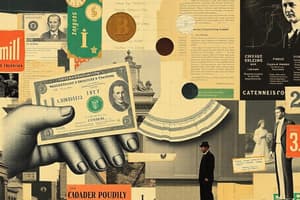Podcast
Questions and Answers
What are the functions of money in an economy?
What are the functions of money in an economy?
Money serves as a medium of exchange, a unit of account, a store of value, and a means of payment.
How do governments impact money in most modern economies?
How do governments impact money in most modern economies?
Governments issue money in the form of coins and banknotes, determine monetary policy, and regulate interest rates and inflation.
Describe loans as a type of credit.
Describe loans as a type of credit.
Loans provide funds upfront with a fixed term, specified repayment schedule, and regular installments covering both principal and interest.
What is credit and how does it work?
What is credit and how does it work?
Explain lines of credit and how they differ from traditional loans.
Explain lines of credit and how they differ from traditional loans.
What are the consequences of carrying over balances on a line of credit without paying them off?
What are the consequences of carrying over balances on a line of credit without paying them off?
Flashcards are hidden until you start studying
Study Notes
Understanding Money and Credit
Money is a medium of exchange that society has agreed upon for facilitating economic transactions. It serves several functions, including acting as a unit of account, a store of value, and a means of payment. In most modern economies, governments issue money in forms such as coins and banknotes, which are legal tender. Governments also determine their currency's monetary policy, which impacts interest rates and inflation among other factors.
Credit refers to borrowing money from others with the promise to repay it later. Borrowers typically pay back more money than they initially received due to the lender charging them interest on the loan amount. There are three main types of credit, each with its own unique features:
-
Loans - These involve receiving funds upfront from a lender, often with a fixed term and specified repayment schedule, usually consisting of regular installments that cover both principal and interest. An example would be taking out a mortgage to buy a house.
-
Lines of Credit - These allow individuals to borrow only what they need when needed, rather than accepting all the money at once like loans do. Interest isn't charged until the line of credit is used, so there may be periods where you don't owe anything on your card balance; however, if you carry over any balances into future months without paying off the full monthly charge, you will accrue significant interest charges.
-
Charge Cards - Unlike debit cards and prepaid cards, these require users to pay the entire bill every month, but can be expensive because companies usually charge high annual fees and set relatively low spending limits compared to credit cards.
In summary, while money is the base unit of financial activity in any economy, helping people to trade goods and services, credit allows us to make purchases now even though we might not have enough money immediately available. Both concepts play crucial roles in our lives by enabling transactions and providing access to capital when needed.
Studying That Suits You
Use AI to generate personalized quizzes and flashcards to suit your learning preferences.




